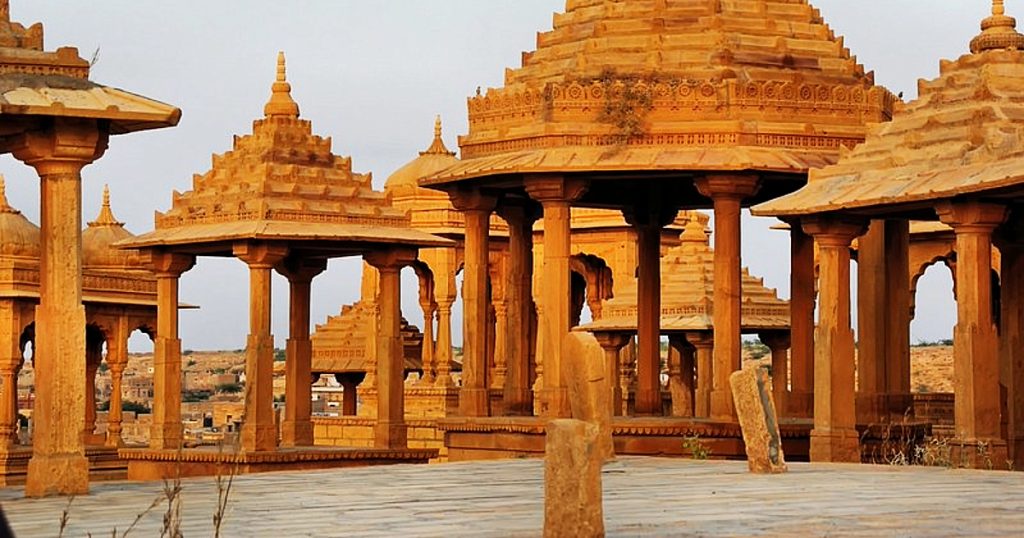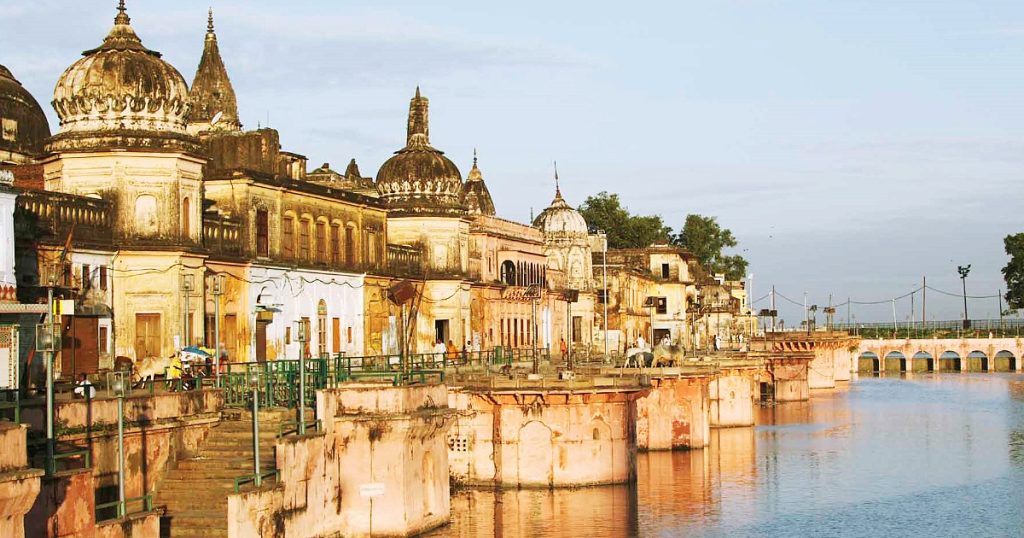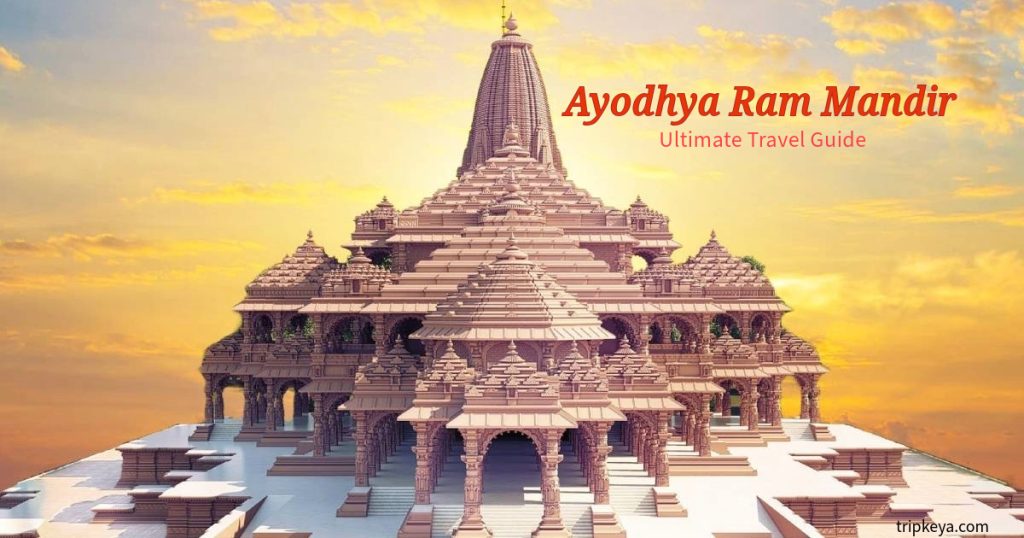22 January 2024 was a big day for the Hindus of the world. Because this was the day when the grand inauguration of Shri Ram Temple took place in Ayodhya. But, why this temple is very important for every Hindu in the world? The Ayodhya Ram Mandir is also known as the Ram Janmabhoomi Temple. This temple holds profound significance in Indian history, culture, and politics. Located in Ayodhya, Uttar Pradesh, India, the temple stands at the site believed by many Hindus to be the birthplace of Lord Rama, a central figure in the Hindu epic, the Ramayana, and the seventh avatar of the Hindu god Vishnu. Ayodhya Ram Mandir, with its ethereal charm, whispers tales of antiquity and legend. It is a place where every stone carries the weight of millennia, where each step echoes the footsteps of saints and pilgrims across ages.
Ayodhya Ram Mandir – Ultimate Travel Guide
Table of Contents
- Ayodhya Ram Mandir – Ultimate Travel Guide
- History of Ayodhya Ram Mandir
- Why You Should Visit Ayodhya Ram Mandir?
- How to Reach Ayodhya Ram Mandir?
- Best Time to Visit Ayodhya Ram Mandir
- The Best Accommodation in Ayodhya
- The Ayodhya Ram Mandir’s Aarti times are as follows:
- Some important things to keep in mind while in Ayodhya Ram Mandir
- Conclusion
Rising magnificently against the blue sky, the Ram Mandir is a symphony in stone that is a monument to heavenly inspiration and human creativity. Its elaborate carvings tell tales of bravery, love, and morality as its spires climb upward into the endless sky.
As soon as one enters the sacred grounds of the Ram Mandir, they are surrounded by a peaceful, serene aura that seems to be time standing still in honor of Lord Ram’s timeless principles.
In this article, I have provided all the important and knowledgeable information that you should know about Ayodhya Ram Mandir.
History of Ayodhya Ram Mandir
Ayodhya’s history dates back thousands of years; it appears in holy books such as the Ramayana, one of Hinduism’s greatest epics. Legend has it that King Manu, the Hindu conception of the ancestor of humanity, established Ayodhya. The ancient Kosala Kingdom, controlled over centuries by many dynasties, had this location as its capital.
Ayodhya’s popularity peaked under King Dasharatha’s rule, who was Lord Rama’s father. The life of Rama, his banishment, and his ultimate return to Ayodhya following his victory over the demon king Ravana are all told in the epic Ramayana.
But Ayodhya’s history is also replete with moments of turmoil and strife, most famously the controversy surrounding the Babri Masjid, a mosque built by the Mughal Emperor Babur in the sixteenth century. The construction of the mosque on the location that Hindus consider to be Lord Rama’s birthplace sparked a lengthy legal and sociopolitical conflict.
The controversy was resolved in 2019 when the Indian Supreme Court granted permission for a Hindu temple to be built on the property and allotted another plot of land for the building of a mosque. This decision was a turning point in Ayodhya’s history and demonstrated the city’s ongoing religious and cultural significance in India. On 22 January 2024, the consecration of Ram temple took place and a grand statue of Lord Rama was placed in the temple. Presently, Ayodhya is a global hub for pilgrims and tourists, serving as a symbol of faith and harmony.
Why You Should Visit Ayodhya Ram Mandir?

Beyond religious lines, visiting the Ayodhya Ram Mandir has cultural, historical, and spiritual value. Here are 10 compelling reasons why you should consider visiting the Ram Mandir:
Cultural Heritage
The Ayodhya Ram Mandir is a testament to India’s rich cultural heritage, showcasing intricate architecture, sculptures, and artwork reflecting centuries of artistic brilliance and craftsmanship.
Historical Importance
Ayodhya is steeped in history, believed to be the birthplace of Lord Rama, a revered figure in Hindu mythology. Visiting the Ram Mandir offers an opportunity to delve into the historical significance of Ayodhya and its role in shaping India’s religious and cultural landscape.
Spiritual Reflection
Regardless of one’s religious beliefs, the serene atmosphere of the Ram Mandir provides a space for spiritual reflection and contemplation, allowing visitors to connect with their inner selves and experience moments of peace and tranquility.
Interfaith Understanding
The Ayodhya Ram Mandir promotes interfaith understanding and dialogue by welcoming visitors from diverse religious backgrounds. It serves as a symbol of unity and tolerance, fostering mutual respect and appreciation for different spiritual traditions.
Architectural Marvel
The temple’s architecture is a marvel to behold, characterized by intricate carvings, towering spires, and ornate designs that showcase the ingenuity and skill of ancient Indian craftsmen.
Pilgrimage Experience
For many Hindus, visiting the Ram Mandir is a sacred pilgrimage experience imbued with deep spiritual significance. However, Non-Hindu visitors can partake in this sacred journey, gaining insight into the importance of pilgrimage in religious traditions.
Cultural Exchange
The Ram Mandir serves as a platform for cultural exchange and dialogue, providing visitors with an opportunity to engage with local communities, participate in religious ceremonies, and learn about Hindu customs and traditions.
Historical Context
Understanding the history and significance of the Ayodhya Ram Mandir provides valuable insights into India’s complex religious and socio-political landscape, offering visitors a deeper appreciation of the country’s diverse cultural tapestry.
Symbol of Unity
The construction of the Ram Mandir symbolizes a historic moment of unity and reconciliation in India’s religious history, highlighting the power of faith, tolerance, and communal harmony to transcend religious divisions.
Personal Growth
Visiting the Ayodhya Ram Mandir can be a transformative experience that fosters personal growth, spiritual enlightenment, and a deeper connection to one’s inner self and the world around them.
In essence, a trip to the Ayodhya Ram Mandir provides a chance for spiritual renewal, cultural enrichment, and deep connection with India’s rich religious and cultural legacy.
How to Reach Ayodhya Ram Mandir?
There are 3 primary options to reach Ayodhya Ram Mandir: 1. by Air, 2. by Train, and 3. by Road. Let us see the details below.
By Air
Located in Uttar Pradesh, India, Ayodhya Airport, known as Maharishi Valmiki International Airport, is a large airport that serves the cities of Ayodhya and Faizabad. It makes Ayodhya more accessible by serving as a gateway for pilgrims and visitors. It’s easily accessible by flight from major Indian cities, making it a spiritual and historical trip. In addition to serving millions of people’s religious needs, Ayodhya Airport promotes both tourist and commercial growth in the area. Currently, 4 airlines are providing service to Ayodhya.
Indigo Airlines:
- From Delhi: Departing at 11.55 AM, Arriving at 1.15 PM (Daily)
- From Mumbai: Departing at 12.30 PM, Arriving at 2.45 PM
- From Ahmedabad: Departing at 9.10 AM, Arriving at 11.00 AM
Air India Express:
- From Delhi: Departing at 10.00 AM, Arriving at 11.20 AM
- From Bengaluru: Departing at 7.30 AM, Arriving at 10.00 AM (Weds) and Departing at 8.05 AM, Arriving at 10.35 AM (Monday & Thurs)
- From Kolkata: Departing at 12.45 PM, Arriving at 2.30 PM (Weds) and Departing at 1.25 PM, Arriving at 3.10 PM (Monday & Thurs)
- From Gwalior city, Madhya Pradesh: Departing at 8.15 AM, Arriving at 11.20 AM (via Delhi)
SpiceJet:
- From Chennai: Departing at 12.40 PM, Arriving at 3.15 PM
- From Mumbai: Departing at 8.20 AM, Arriving at 10.40 AM (6 days a week)
- From Bangluru: Departing at 10.50 AM, Arriving at 1.30 PM (4 days a week)
- From Ahmedabad: Departing at 6.00 AM, Arriving at 8.00 AM
- From Delhi: Departing at 10.40 AM, Arriving at 12.00 AM
- From Darbhanga city, Bihar: Departing at 11.20 AM, Arriving at 12.30 PM
- From Jaipur city, Rajasthan: Departing at 7.30 AM, Arriving at 9.15 AM
- From Patna, Bihar: Departing at 2.25 PM, Arriving at 3.25 PM
Akasa Air
- From Pune, Maharashtra: Departing at 8.50 AM, Arriving at 12.55 PM (via Delhi) – Flight Number: QP 1607
- From Delhi: Departing at 11.35 AM, Arriving at 12.55 PM – Flight Number: QP 1607
Click Here for more flights to Ayodhya Ram Mandir
By Train
Rich in mythological and religious importance, Ayodhya is home to two important railway intersections: Faizabad Junction and Ayodhya Dham Junction (previously Ayodhya Junction). These stations are essential ports of entry for the millions of visitors and pilgrims who visit the holy city. Moreover, both stations offer easy access to taxis, autos, and rickshaws for onward travel. Additionally, Information booths and tourist assistance services are available for guidance.
Click here to check the timing of the Ayodhya Ram Mandir train.
By Road
Going to Ayodhya by road will truly be a thrilling and unique experience. Because, when you go to Ayodhya by road, excitement will be in the air, boiling like the chai in your thermos, as the motor roars under you. Ahead, pathways unfold, offering a journey to the holy center of Ayodhya. As dust dances in the sunshine, ochre hues are painted onto landscapes. Temples entice with the promise of tranquility, while villages whisper stories of long-gone legends. You make stops at roadside stands where you enjoy hot samosas and tea while grinning at kind people. The trip itself turns into a pilgrimage, leaving memories that go beyond the place of arrival. The sunsets, illuminate the sky with flaming hues, as the spires of Ayodhya rise into the distance, marking the end of your epic road adventure.
Ayodhya is well-connected to all big cities by road. You can go here by your vehicle and also by government and private buses. Uttar Pradesh government’s UPSRTC bus service is also available from Delhi to Ayodhya.
Best Time to Visit Ayodhya Ram Mandir

Ram Mandir in Ayodhya is one of the popular temples in India. So, there is a crowd of people in Ayodhya throughout the year. But, here I also want to clarify that visiting Ayodhya completely depends on you. This holy city is made even more charming and alluring by the varied experiences and chances each month offers to interact with its rich history. Here I have compiled the best time to visit Ayodhya Ram Mandir month by month.
January – February
When the winter cold descends over India’s northern plains, January and February become great times to visit Ayodhya. This is the perfect time of year for outdoor touring because of the fresh, energizing weather, clear skies, and appropriate temperatures. Wandering around Ayodhya’s old alleyways, visitors may take in the elaborate architecture of the temples and holy sites devoted to Lord Rama.
March – April
Ayodhya comes alive with the brilliant colors and joyous energy of Ram Navami as spring approaches. Ram Navami, which commemorates the birth anniversary of Lord Rama, is celebrated with unmatched zeal and devotion, drawing visitors from all over the world to the city’s hallowed grounds. The sound of hymns being chanted, the aroma of incense fills the air, and the joyful enthusiasm of devotees fills the Ram Mandir as they come to get blessings and participate in the holy celebrations.
May – June
May and June bring in a season of reflection and spiritual introspection as the warm summer light embraces Ayodhya. Even while the intense heat may discourage some visitors, those who persevere in the heat are rewarded with peaceful moments spent amidst the revered landmarks of Ayodhya. The peacefulness of the Sarayu River provides relief from the intense heat, enticing tourists to take leisurely boat trips and experience the ethereal atmosphere of this historic city.
July – August
In July and August, Ayodhya experiences the monsoon, which brings with it verdant foliage and cool rains that revitalize both the body and the spirit. Ayodhya has a feeling of rejuvenation and liveliness during the monsoon season as the soft sound of rainfall hits the roof and lifts the remnants of the past. Full of rainwater, the Ram Kund is a holy reservoir that is said to have been blessed by Lord Rama himself. Devotees can perform cleansing ceremonies and find spiritual comfort in the peaceful environs.
September – October
September and October announce the arrival of fall in Ayodhya as the monsoon fades, illuminating the city in shades of red and gold. It’s the perfect time to see Ayodhya’s many sites, such as the tranquil Kanak Bhawan and the imposing Hanuman Garhi. Because the temperature turns delightfully moderate. During Dussehra, the celebrations intensify to a climax when the effigies of the demon king Ravana are set on fire, signifying the victory of good over evil.
November – December
As the year draws to a close, November and December cast a magical spell over Ayodhya, enveloping the city in a nostalgic aura of spirituality and devotion. The crisp winter air is infused with the fragrance of incense and the melodious strains of devotional songs, creating an atmosphere of reverence and piety that is palpable at every corner. Visitors can immerse themselves in the timeless charm of Ayodhya’s ancient temples and sacred ghats, forging a deep and lasting connection with the spiritual essence of this sacred city.
So, Ayodhya entices travelers year-round with diverse experiences and spiritual growth opportunities. Regardless of the weather, it inspires seekers.
The Best Accommodation in Ayodhya
Ayodhya offers various accommodation options. in Ayodhya you can find Dharamshala, guesthouses, homestays, and hotels, catering to different preferences and budgets. Here I have compiled some of the best and budget-friendly accommodations for you.
Dharamshala
Birla Dharamshala
Situated on Ayodhya Road, this Dharamshala offers modest, uncluttered rooms with communal toilets and fans. It is famous for its welcoming personnel and tranquil setting. The starting price each night is about ₹300.
Gujarati Dharamshala
This Dharamshala, which is close to the Ayodhya Railway Station, provides inexpensive, dormitory-style lodging and simple food. For tourists on a tight budget who don’t mind sharing accommodations, it’s a great choice. The starting price each night is about ₹250.
Sri Ram Sthal Dharamshala
This budget hotel in Dharamshala is close to Hanuman Garhi and offers simple, clean rooms at reasonable prices with connected bathrooms and hot water. For those looking for a handy location close to important temples, it’s a wonderful option. The starting price is about ₹400 per night.
Kanak Bhawan Dharamshala
Near Ayodhya Dham Junction, this Dharamshala has air conditioning, hot water, and adjacent restrooms. It also features a garden and a café. The starting price is about ₹700 per night.
Sahu Dharamshala
This Dharamshala is close to Ram Ki Paidi and offers air-conditioned rooms with Wi-Fi, hot water, and connected bathrooms. It also features a parking area and a restaurant. The starting price is about ₹800 per night.
Sri Ram Katha Park Dharamshala
This Dharamshala, which is close to the Ayodhya Bypass Road, has large rooms with connected bathrooms, air conditioning, hot water, and Wi-Fi. It contains a restaurant and a garden as well. Starting prices are around ₹1,000 per night.
Remember that Dharamshalas are designed to offer pilgrims simple, reasonably priced lodging. Expect a basic and pleasant lodging that lets you concentrate on your spiritual journey rather than opulent comforts.
Guest Houses
Jamvant Guest House
Located directly in front of Jamwant Kila (Fort) on Nazarbag Hanuman Gardhi Road in Ayodhya. The Hanuman Garhi temple and probably the Ayodhya by-pass route are close by, based on this location. Starting prices are around ₹1,120 per night.
Shakti Guest House
Located in Ayodhya, around 900 meters from Ram Mandir and 150 meters from the Ayodhya Dham Junction Railway Station. The location gives good closeness to the holy site and convenience for those coming by rail. Moreover, Hot water, clean drinking water, and additional beds upon request are basic amenities. Starting prices are around ₹1,400 per night. For more details, visit https://yatradham.org/ayodhya-shakti-guest-house.html
Gupta Guest House
Located next to Tulsi Udyan (garden) at Nayaghat, Ayodhya. This means that the Naya Ghat bathing region and the Saryu River are somewhat close by.
Specific details about the amenities that Gupta Guest House offers differ widely between platforms. This is an assortment: laundry services, 24-hour front desk, medical treatments (details unknown) upon request, Room service,24-hour electricity source, etc. Starting prices are around ₹1,700 per night
Tips to help you choose the ideal guest house for your stay in Ayodhya:
Budget: Ayodhya’s guest homes range in price from low-cost to moderately priced. Determine the amount of money you can afford to spend each night.
Location: Where do you want to be? Close to the action near Ram Mandir, in a quieter area, or near specific landmarks like the Saryu River?
Facilities: Which facilities are most essential to you? Wi-Fi, air conditioning, laundry facilities, and access to hot water? Look for detailed descriptions of offered amenities. Don’t hesitate to contact the guest house directly for clarification.
Online Reviews: Examine reviews from websites such as TripAdvisor, Goibibo, and MakeMyTrip. This assists in evaluating the visitor experience and finding possible problems. For more details, see if the guest house has an official website or social media profile.
Seasonality: Depending on the time of year, prices may change. If you want to save money, think about visiting during the off-season.
Distance to Ram Mandir: Walking is a frequent way of transportation in Ayodhya, including the distance to Ram Mandir. Take into account the walking distance from the guest house if being close to the temple is important.
The focus of Guest homes: Certain guest homes may provide for certain demands, such as vegetarian food or low-cost travel. Choose the one that best suits your needs.
Homestays
If you want to mingle with the people of Ayodhya then homestay is the best option for you. Because homestay means that the people living there have kept some rooms for the visiting tourists. So, Here are some highly-rated homestays with their price ranges to help you decide.
Meera Sadan Homestay
This homestay provides tidy, comfortable rooms with basic facilities like Wi-Fi and connected bathrooms starting at ₹920 per night. It is near the Chowk on Ayodhya Road and gets high praise for its welcoming host and cozy ambiance.
Rashi Homestay
This homestay offers air-conditioned, large rooms with balconies overlooking gardens and attached bathrooms, starting at ₹920 a night. Moreover, It is famous for its mouthwatering handmade breakfast and is located close to the Faizabad Road in a tranquil neighborhood.
Vinayak Homestay
This homestay offers cozy rooms with connected bathrooms, air conditioning, and Wi-Fi starting at ₹1,500 per night. Additionally, It is popular for its tidy and well-kept amenities and is close to Ayodhya Road.
Hotels
Clarks Inn Express Hotel
This inexpensive hotel offers tidy, comfortable rooms with basic facilities like Wi-Fi and connected toilets starting at ₹2,500 per night. It’s a fantastic choice for anyone looking for a convenient and reasonably priced place to stay, and it’s close to Faizabad Road.
Cygnett Collection KK Hotel
Starting from ₹3,000 per night, this stylish hotel features well-equipped rooms, a rooftop restaurant with city views, and a fitness center. It’s located near Faizabad Road and is known for its friendly staff and modern amenities.
Park Inn by Radisson Hotel
Starting from ₹3,500 per night, this modern hotel offers comfortable rooms with contemporary décor, a swimming pool, a fitness center, and a restaurant. It’s located near Faizabad Road and is popular for its convenient location and good value for money.
The Mansarovar Palace
This grandiose palace-turned-hotel provides sumptuous accommodations with large rooms, marble baths, and a grand lobby starting at ₹7,000 per night. It has several eating options, a spa, and a swimming pool. It is close to the Faizabad Road.
The Royal Heritage Hotel & Resort
This resort-style hotel offers a fusion of elegance and comfort with well-appointed rooms, a swimming pool, a spa, and several dining options starting from ₹4,500 per night. Situated on the Lucknow Highway, it provides picturesque vistas and a tranquil atmosphere.
Note: These are very few names of hotels in Ayodhya. You can find so many hotels and resorts in Ayodhya from budget-friendly to luxurious. So, always check online before booking your accommodation.
The Ayodhya Ram Mandir’s Aarti times are as follows:
There are 6 aartis performed every day in Ayodhya Ram Mandir which are as follows:
- Shringar Aarti: Morning Aarti at 4.30 AM
- Mangal Aarti: at 6.30 AM. After this aarti, devotees are allowed for holy sightings (Darshan)
- Bhog Aarti (Mid-day Offering): 12:00 PM
- Sandhya Aarti (Evening Aarti): 7:30 PM
- Bhog Aarti (Evening Offering): 8:00 PM
- Shayan Aarti (Night Aarti): 10:00 PM
How to participate in Ayodhya Ram Mandir Aarti
There are below 2 options you can participate in Ayodhya Ram Mandir Aarti.
Offline Facility:
If you have not confirmed your online booking for Aarti, you can get a pass from the Shri Ram Janmbhoomi camp office. They will give you a pass after proper identification. So, it is always good to keep any identity proof with you.
Online Facility:
You can online register at https://online.srjbtkshetra.org/#/aarti. For online registration, You will have to create a profile with your mobile number and then you can register online. Before registering, I recommend reading the instructions properly.
Note: A wheelchair facility is also available for the elderly and disabled in Ayodhya.
Some important things to keep in mind while in Ayodhya Ram Mandir
Here are some very important tips to keep in mind while in Ayodhya Ram Mandir:
Research and Planning
- Do your research: Examine the dress code, manners, customs, and culture of the place you are visiting before you travel. By doing this, you may respect the local way of life and prevent misunderstandings.
- Make travel plans: Make a rough schedule including the main attractions, things to do, and ways to get about. You may maximize your time and prevent feeling overburdened by doing this.
- Learn some basic vocabulary: Gaining some basic knowledge of the local language might be quite beneficial. It can be beneficial when connecting with locals and shows effort.
Packing and Requirements
- Pack light: Choose clothes that are adaptable and can be combined and matched. Think about wearing layers so you can adapt to changing weather conditions.
- Make copies of important documents: Make copies of all of your vital papers, including your ID, passport, travel insurance, and other records. In case of loss, keep them apart from the originals.
- Download important apps: To make navigation easier, download offline maps, currency converters, and translation applications.
Safety and Security
- Observe your surroundings: Remain careful and mindful of your belongings, particularly in busy spaces.
- Ayodhya Ram Mandir is safe. However, if any circumstance makes you feel unsafe, get out of there.
- Learn about the regulations and avoid any activities that can be considered offensive.
Cultural Sensitivity
- When visiting places of worship, dress modestly out of respect for regional traditions.
- Generally, photography and videography within the sanctum sanctorum are forbidden. However, when taking pictures, use caution and always get permission before shooting subjects or places of worship.
- When haggling at local marketplaces, do so courteously and equitably. Steer clear of aggression.
Additional Tips
- Be aware of offerings: Don’t bring offerings from yourself, such as flowers or prasad. They are available within the compound of the temple. Comply with any instructions provided by the temple regarding offerings.
- Observe others’ customs: Show consideration for the prayers and rites performed by other devotees. When you’re inside the temple, act with reverence.
- Welcome the unanticipated: Unplanned occurrences and discoveries may sometimes make for the most memorable travel experiences. Enjoy the trip and have an open mind to new things.
- Stay hydrated: since Ayodhya may get hot. Remain hydrated and carry a water bottle, especially during the busiest time of year.
- Footwear: Since you may be walking throughout the place, wear comfortable shoes.
- Darshan flow: Follow the queue and move along respectfully. Avoid spending too much time in front of the god.
- Personal belongings: Do not carry cell phones, wallets, electronic devices, purses, or bags inside. Utilize the cloakroom facilities in the Pilgrim Facilitation Complex to store these items.
- When to visit: There are many of people visiting the temple. So, think about choosing weekdays over weekends or early mornings for fewer lines.
- Shoes: Before entering the temple complex, take off your shoes.
Conclusion
So, Set off on a soul journey to Ayodhya, where the Ram Mandir stands as a symbol of the eternal strength of faith. Let your heart linger with recollections of old songs and rich history as our ultimate trip guide comes to an end. Ayodhya is a spiritual journey waiting to be discovered, not merely a place to visit. Everywhere one looks, from elaborate shrines to busy marketplaces, one can feel the influence of Lord Ram. For those looking for comfort or enlightenment, Ayodhya provides a life-changing experience. Accept the holy spirit of this holy city, for it will envelop you in a profound sense that will link you to something far bigger than yourself. Have a great and spiritual trip!
Hey there! I’m Kartik. I am a finance professional and a travel and lifestyle blogger. I am vegetarian, but I love adventuring food. Jeric and I work together to deliver high-quality content for you. Adventure the fun!




